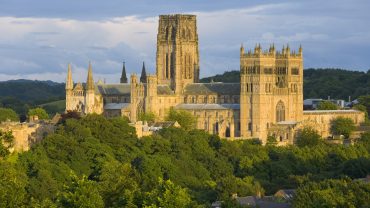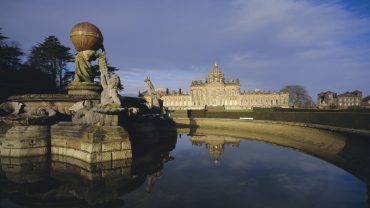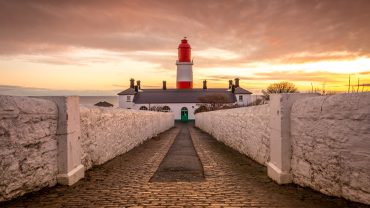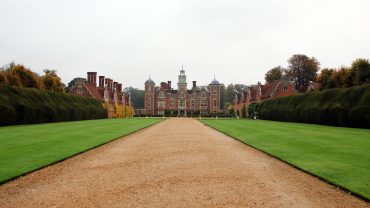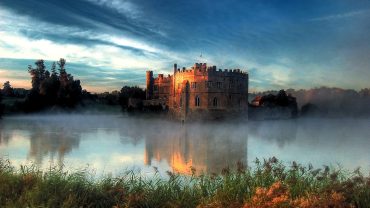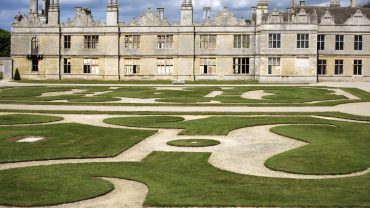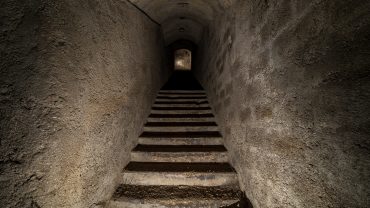The manor house is a quintessential symbol of England’s medieval and feudal past, serving as the residence of the lord of the manor and the administrative hub of a manorial estate. These grand mansions were often located at the heart of rural estates, surrounded by huge tracts of land. Architecturally, they were designed to reflect both the wealth and status of their owners, with features such as great halls for gatherings, fortified walls for defence or prestige, and sprawling grounds.
Over time, the term ‘manor house’ has come to refer more broadly to elegant country homes, though their historical roots remain deeply tied to England’s feudal system. These unique manor houses are all distinctive in their own way, but what sets them apart?
Hold on to your top hats – we’re about to tour some of the most unique homes in the UK.
What Sets Unusual Mansions Apart?

Coughton Court in Warwickshire, a stunning Tudor manor house (Credit: Leanne Brookes via Getty Images)
The most obvious answer is that – generally speaking – these unusual country houses stand out because of their distinctive design, rich heritage, or unusual quirks.
Some of these unique manor houses boast unusual designs reflecting local materials or climates, while others are distinguished by their owners’ peculiar tastes. For instance, Snowshill Manor in Gloucestershire is renowned for its eclectic collection of curiosities amassed by its eccentric owner Charles Wade. Meanwhile, Wentworth Woodhouse in South Yorkshire stands out for its sheer scale and grandeur, featuring the longest façade of any house in England. These distinctive elements make these houses fascinating windows into the lives and tastes of those who built and lived in them. Here are some of the UK’s unique homes.
Chastleton House, Oxfordshire
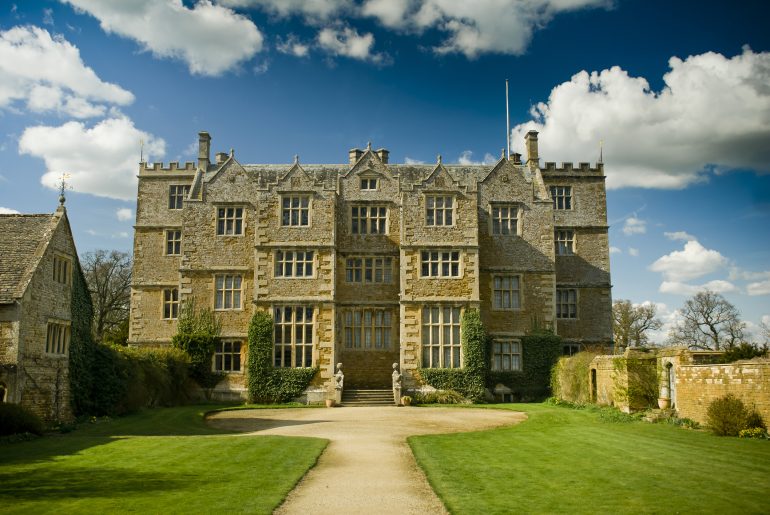
Chastleton House in Oxfordshire (Credit: Snowshill via Getty Images)
Chastleton House, near Moreton-in-Marsh in the Cotswolds, is a striking example of Jacobean architecture and a unique time capsule of English history. Built between 1607 and 1612 by lawyer Walter Jones, the house features stepped gables, pinnacles, and mullioned windows, embodying the grandeur of its era.
What makes Chastleton House one of the more unusual country houses in the UK is its remarkable preservation. Owned by the same family for nearly 400 years before passing to the National Trust in 1991, it has been maintained under a ‘controlled decay’ policy rather than restoration. This approach allows visitors to experience the house as it was historically, complete with original Jacobean furniture and decoration.
The house also holds fascinating historical anecdotes. During the English Civil War, Sarah Jones is supposed to have saved her Royalist husband Arthur by hiding him in a secret room and reportedly drugged Cromwell’s soldiers with laudanum-laced beer. Additionally, Chastleton is often credited as the birthplace of croquet as a competitive sport in the mid-nineteenth century by Walter Whitmore Jones who codified the rules. These stories enrich Chastleton’s legacy as more than just a stately home steeped in intrigue and innovation but one of the most unique manor houses in the UK.
Cragside, Northumberland

Cragside in Northumberland (Credit: Lusky via Getty Images)
Cragside, located near Rothbury in Northumberland, is one of the most innovative and unusual country houses in the UK. Built by industrialist and inventor William Armstrong between 1863 and 1884, Cragside’s Tudor Revival design, perched on a rugged hillside, was once called “the most dramatic Victorian mansion in the North of England.” However, what makes Cragside a unique home in the UK is its pioneering technological advancements. It was the first house in the world to be lit by hydroelectric power, showcasing Armstrong’s engineering brilliance.
Cragside was equipped with cutting-edge features for its time, including a hydraulic lift, water-powered rotisserie, and an early dishwasher. Armstrong also constructed artificial lakes and dams to generate power for the estate. Beyond its technological marvels, Cragside boasts lavish interiors filled with exotic fabrics, gothic carvings, and beautiful stained glass. Today managed by the National Trust, Cragside remains an extraordinary testament to Victorian innovation and imagination.
Stokesay Castle, Shropshire

The original gatehouse at Stokesay Castle (Credit: PaulaConnelly via Getty Images)
Not far from the Welsh border, Stokesay Castle is widely regarded as one of the finest and best-preserved medieval fortified manor houses in England. Built in the late thirteenth century by a wealthy wool merchant named Laurence of Ludlow, unlike many medieval sites, Stokesay is one of the more unusual mansions in the UK in that it has remained remarkably unchanged since its construction, offering visitors a rare glimpse into life during the Middle Ages.
What makes Stokesay Castle particularly unusual is its architectural integrity and tranquil setting. The castle’s timber-framed seventeenth century gatehouse is magnificent in itself, while its moat and surrounding landscape enhance its medieval character. Despite being besieged during the English Civil War in 1645, Stokesay escaped significant damage. Now managed by English Heritage, much of what has now become one of the most unique manor houses in Britain, remains just as it did when it was first constructed.
Montacute House, Somerset

Montacute House, Somerset (Credit: flowersandclassicalmusic via Getty Images)
Montacute House in Somerset is a masterpiece of Elizabethan Renaissance design and one of the most distinctive and unique homes in Britain. Completed in 1601 for Sir Edward Phelips, a prominent lawyer (he was the prosecutor of Guy Fawkes in the trial of the Gunpowder Plotters) and later Speaker of the House of Commons, the house was conceived as a bold statement of wealth and ambition and is known as a ‘prodigy house.’
Indeed, as unusual country houses go, Montacute is right up there. The east front is adorned with statues of the Nine Worthies, and the fifty-two metre Long Gallery, the longest of its kind in England, is home to a collection of Tudor and Elizabethan portraits on loan from the National Portrait Gallery. Montacute’s interiors also boast unusual details, such as a plumbed bath hidden in a wardrobe, installed in the early twentieth century. The combination of innovative design, fascinating history, and enduring beauty makes Montacute House a truly unique manor house and celebrated landmark among Britain’s country houses.
Stonor Park, Oxfordshire

Stonor Park in Oxfordshire (Credit: Meowgli via Getty Images)
Stonor Park in Oxfordshire’s stunning Chiltern Hills is one of Britain’s oldest continuously inhabited country houses, with origins dating back over 750 years. The house showcases a fascinating blend of medieval, Tudor, and Georgian architecture, and during the Reformation, the Stonor family sheltered Jesuit priests including Edmund Campion in secret attic rooms. Yet what sets Stonor Park apart as one of the nation’s most unusual mansions is that the grounds are home to a stone circle – the reason for the estate’s name.
Still a family home today, Stonor Park offers visitors an atmospheric experience of history, faith, and heritage. Its unique blend of architectural styles – including a stunning twelfth century chapel made of flint and stone – religious intrigue, and ancient landscape make it one of the UK’s most captivating and unique manor houses.
Erddig, Wrexham

The facade of Erddig in Wales (Credit: BrendanHunter via Getty Images)
Erddig, located just south of Wrexham in Wales, is one of Britain’s most distinctive and unusual country houses, renowned for its remarkable preservation and unique social history. Built between 1684 and 1687 for Joshua Edisbury, the High Sheriff of Denbighshire, the house was expanded in the early eighteenth century and was owned by lawyer John Mellor, and then inherited by his nephew Simon Yorke in 1733. It remained in the hands of the Yorke family before being passed to the National Trust in 1973.
What sets Erddig apart as one of the most unique homes in the UK is its unusually close relationship between the family and their servants. The Yorkes commemorated their staff through a unique collection of portraits, photographs, and poems, offering an intimate glimpse into the lives of those who worked on the estate between the eighteenth and the twentieth century. Architecturally, Erddig is relatively plain on the outside, but its interiors are outstanding, with original furnishings, rare Chinese wallpaper, and a magnificent lit à la duchesse canopy bed. The estate also boasts one of Britain’s most important surviving eighteenth century walled gardens.
Basildon Park, Berkshire

One of the arched entrances to Basildon Park (Credit: Peter Fleming via Getty Images)
Basildon Park in Berkshire is a striking example of eighteenth century Palladian architecture. Designed by John Carr of York and built between 1776 and 1783 for politician and landowner Sir Francis Sykes, the mansion’s classical façade, central block, and flanking pavilions reflect the influence of Italian Renaissance architect Andrea Palladio, while its interiors showcase refined neoclassical ‘Adamesque’ detailing.
The estate’s history is as dramatic as its architecture. After the Sykes family, Basildon Park passed to the Morrison family in the nineteenth century, becoming a hub for local society events, but by 1910 it was empty. It was requisitioned by the British government as a convalescent home and military camp, and there was even the possibility of it being dismantled for relocation to the United States. By the early 1950s, Basildon Park was derelict, but in 1952, Lord and Lady Iliffe bought the ruined house and painstakingly restored it, blending historic character with modern comforts. They filled the mansion with antiques and revived its social spirit, hosting glamorous gatherings before gifting it to the National Trust in 1978. One of the most unusual country houses in the UK, today it’s celebrated not only for its architectural elegance but also for its remarkable story of survival and restoration.
Stourhead, Wiltshire

The stunning gardens at Stourhead (Credit: krzych-34 via Getty Images)
Stourhead in Wiltshire is famed for its stunning Neo-Palladian mansion and world-renowned eighteenth century landscape gardens. Acquired by banker Henry Hoare – known as Good Henry – in 1717, the estate was transformed by his son, Henry Hoare II – known as Henry the Magnificent – who created the gardens inspired by classical art and the Grand Tour. From 1741, he designed a dramatic landscape featuring a winding lake, classical temples, grottos, and follies, each carefully placed to evoke scenes from Virgil’s Aeneid and create a theatrical journey for visitors.
What makes Stourhead one of the most unique manor houses in the UK is its immersive, storybook quality. The gardens guide visitors along a path revealing breathtaking views and architectural highlights such as the Pantheon, Temple of Apollo, a replica of the Borghese Vase, a five-arched Palladian bridge, and a mysterious grotto. This harmonious blend of art, mythology, and nature remains largely unchanged since the eighteenth century. The mansion itself was expanded over generations, with additions such as a library and picture gallery, and it was restored after a devastating fire in 1902.
In 1946, Sir Henry Hugh Arthur Hoare gifted the estate to the National Trust, ensuring its protection. Today, Stourhead offers a timeless experience where architecture, history, and landscape design combine to create one of Britain’s most extraordinary and unusual country houses and gardens.


